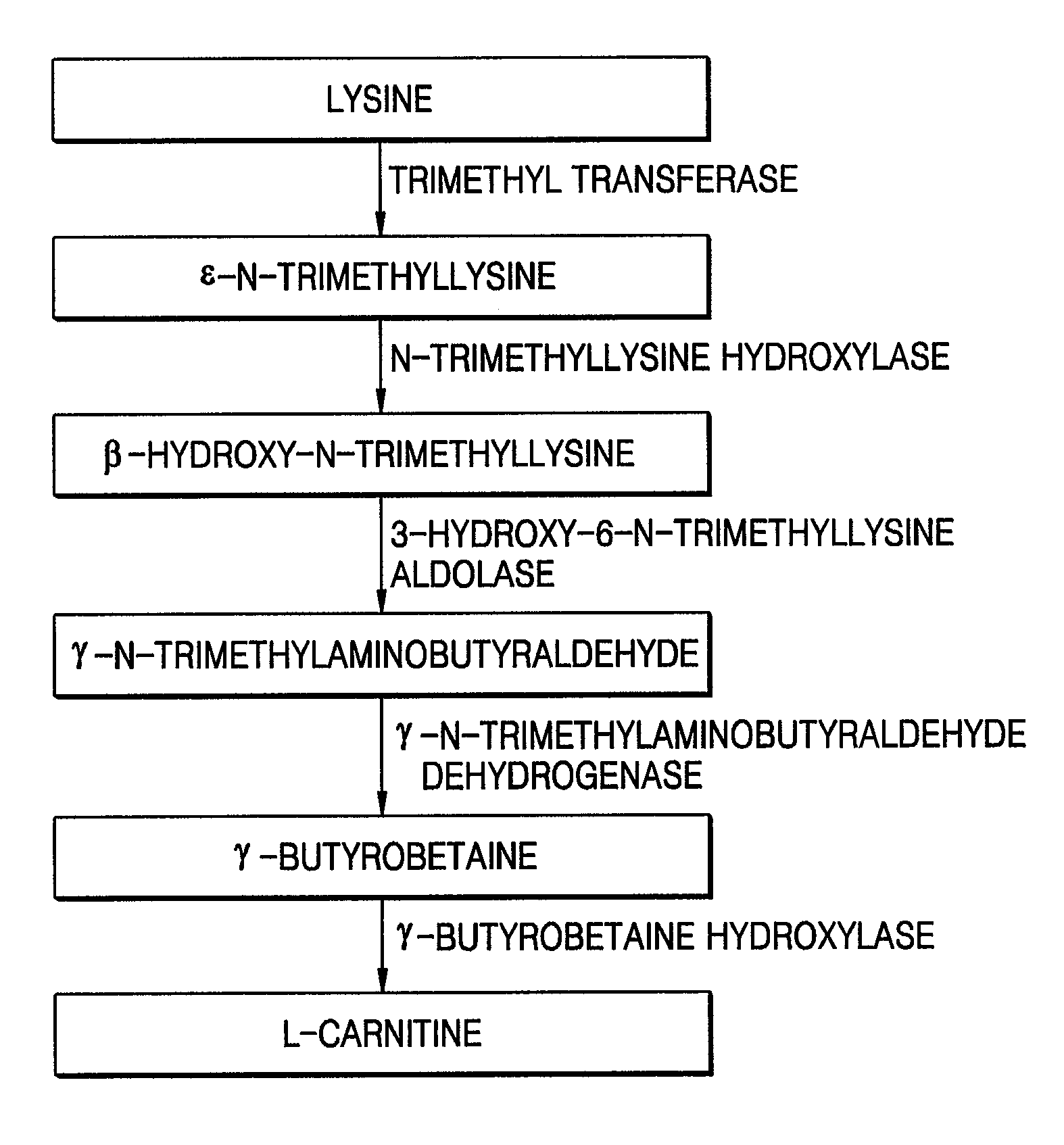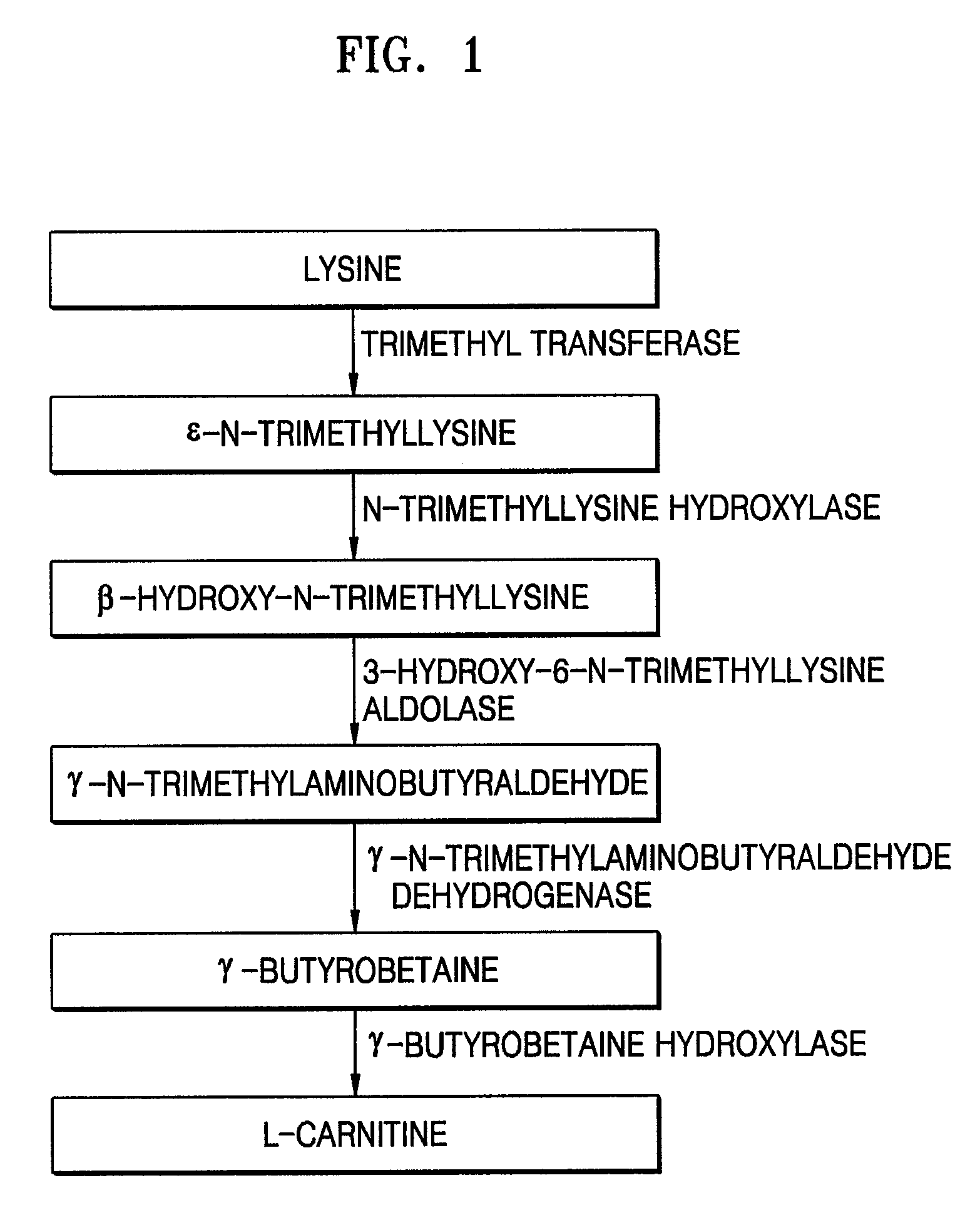Microorganism of Enterobacteriacae genus harboring genes associated with L-carnitine biosynthesis and method of producing L-carnitine using the microorganism
a technology of enterobacteriacae and microorganisms, which is applied in the field of microorganisms belonging to the family enterobacteriaceae, can solve the problems of low yield of l-carnitine, high reaction mixture ratio of -ketoglutarate and reducing agent (i.e., ascorbate), and unstable dehydrocarnitine, and achieves high yield
- Summary
- Abstract
- Description
- Claims
- Application Information
AI Technical Summary
Benefits of technology
Problems solved by technology
Method used
Image
Examples
example 1
Separation of Four Polynucleotides, Respectively, Encoding N-trimethyllysine Hydroxylase (TMLH), 3-Hydroxy-6-N-Trimethyllysine Aldolase (SHMT), γ-Trimethylaminoaldehyde Dehydrogenase (TMABADH), and γ-Butyrobetaine Hydroxylase (BBH) from Neurospora crassa
[0035]In this Example, four polynucleotides encoding respective TMLH, SHMT, TMABADH, and BBH were separated from Neurospora crassa and cloned, and the sequence analyses of the cloned polynucleotides were performed.
[0036](1) Preparation of cDNA Library of Neurospora crassa
[0037]Total mRNAs were separated from a culture containing the fungus thallus (including the sporophyte) of Neurospora crassa and reversely transcribed using a poly-T primer. The obtained cDNAs were amplified by PCR, digested with EcoRI and XhoI, and inserted into the EcoRI-XhoI site of a λ AD5 cloning vector, to prepare a Neurospora crassa-derived cDNA library.
[0038]Next, the cDNA library was transformed into E. coli BNN322. The transformed E. coli BNN322 was cult...
example 2
Construction of Host Cells Containing carB, carC, carD, and carE
[0067]In this Example, the carB and carE genes were amplified from the Neurospora crassa-derived cDNA library prepared in Example 1, and pT7-7BE containing both the genes was constructed. Also, the carC and carD genes were amplified from the Neurospora crassa-derived cDNA library prepared in Example 1, and pACYC184CD containing both the genes was constructed. The pT7-7BE and pACYC184CD thus constructed were introduced into E. coli cells to obtain transformed cells containing all the carB, carC, carD and carE genes. The transformed cells were designated as E. coli DH5α CJ2004, and deposited in the international depository Korean Culture Center of Microorganisms (KCCM) on Jan. 27, 2004 (accession number: KCCM-10581).
[0068](1) Construction of pT7-7BE Containing Both the carB and carE Genes
[0069]First, the carB gene was amplified using the Neurospora crassa-derived cDNA library as a template and oligonucleotides of SEQ ID N...
example 3
Production of L-Carnitine Using Strains Containing Polynucleotides Encoding TMLH, SHMT, TMABADH and BBH
[0072]In this Example, E. coli BL21 (DE3) strains respectively transformed with pT7-7carB, pT7-7carC, pT7-7carD, and pT7-7carE constructed in Example 1 were mixedly cultured in a trimethyllysine-containing medium and then the production of L-carnitine was measured. In addition, E. coli BL21 (DE3) strains co-transformed with pT7-7BE and pACYC184CD constructed in Example 2 were cultured and then the production of L-carnitine was measured.
[0073](1) Mixed Culture of E. coli BL21 (DE3) Strains Respectively Transformed with pT7-7carB, pT7-7carC, pT7-7carD, and pT7-7carE
[0074]First, the E. coli BL21 (DE3) strains respectively transformed with pT7-7carB, pT7-7carC, pT7-7carD, and pT7-7carE were plated onto ampicillin (100 μg / ml)-supplemented LB solid media and cultured. Cell colonies of each culture were cultured in a flask containing 20 ml of an ampicillin (100 μg / ml)-supplemented LB medi...
PUM
| Property | Measurement | Unit |
|---|---|---|
| pH | aaaaa | aaaaa |
| γ-trimethylaminoaldehyde dehydrogenase activity | aaaaa | aaaaa |
| γ-butyrobetaine hydroxylase activity | aaaaa | aaaaa |
Abstract
Description
Claims
Application Information
 Login to View More
Login to View More - R&D
- Intellectual Property
- Life Sciences
- Materials
- Tech Scout
- Unparalleled Data Quality
- Higher Quality Content
- 60% Fewer Hallucinations
Browse by: Latest US Patents, China's latest patents, Technical Efficacy Thesaurus, Application Domain, Technology Topic, Popular Technical Reports.
© 2025 PatSnap. All rights reserved.Legal|Privacy policy|Modern Slavery Act Transparency Statement|Sitemap|About US| Contact US: help@patsnap.com



